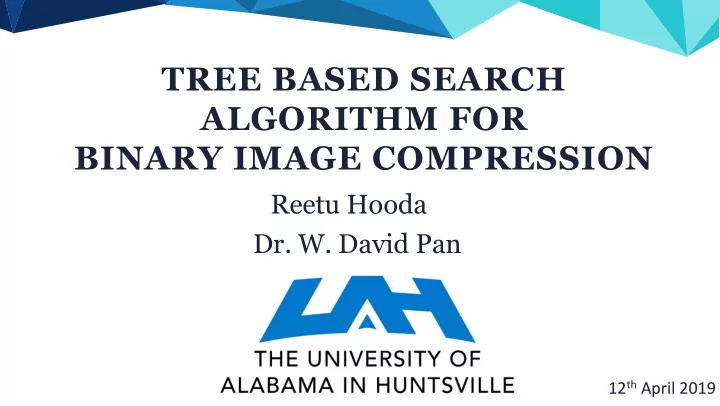

TREE BASED SEARCH ALGORITHM FOR BINARY IMAGE COMPRESSION Reetu Hooda Dr. W. David Pan 12 th April 2019
Outline • Introduction • Background • Tree Based Search Algorithm • Simulation Results • Conclusion
Tree-based algorithm Results Introduction Background Conclusion INTRODUCTION • Images contribute to huge part of data and information. • Storage and retrieval of data is challenging. • This work focuses on Lossless Compression of Binary Images. • Tree-based search algorithm : Searches for best grid structure for adaptively partitioning the image into blocks of varying sizes. • Binary image: either “0” or “1”.
Tree-based algorithm Results Introduction Background Conclusion APPROACHES Outline • Insufficient storage and demand for higher transmission rates. • The images found on the web are compressed in some or other formats. • The compression techniques can be classified as: Lossless Compression. Lossy Compression. • A basic image compression algorithm:
Tree-based algorithm Results Introduction Background Conclusion Outline TREE BASED SEARCH ALGORITHM • Several regions of an image are less compressible than other regions. • Changing statistics of an image. • Exploiting the smoothness in portion of an image. • Portions dominated by change : retained as smaller blocks. • Smooth segments : chosen not to be divided further. • Tree based algorithm steps: a. Full search of image sub-blocks. b. Optimal tree structure. c. Two-level splitting of the original image.
Tree-based algorithm Results Introduction Background Conclusion FULL SEARCH OF IMAGE SUB-BLOCK Outline • Divide the image into 4 equally sized blocks • Find the best combination of scanning patterns.
Tree-based algorithm Results Introduction Background Conclusion ADAPTIVE GRID STRUCTURE Outline • Content of an image regions contained in the image. • larger blocks for smooth regions • Smaller blocks for regions with largely varying content. • Binary decisions : full search performed on the sub-blocks. • Non-uniform areas: isolated from the remaining parts of the image.
Tree-based algorithm Results Introduction Background Conclusion Outline TWO-LEVEL RECURSIVE SPLITTING • Image : “original tree” (root node). • Image can be represented by a tree structure. • Segmentation: • Performed iteratively. • Controlled at each step. • Split parent block child node. • Tree structure is designated by series of bits that indicate termination.
Tree-based algorithm Results Introduction Background Conclusion Outline FINAL STRUCTURE • Direction bits : represents division. • Each node has either no offspring or four offsprings. • If the block is divided : • Binary decision for selection of scanning direction. • The procedure terminates after two-level recursive splitting. • Data file : Tree structure and sequence of intervals, header. • Final step: Data compression utility. • Lossless check.
Tree-based algorithm Results Introduction Background Conclusion SIMULATION RESULTS Outline Bitmaps using Tree-based algorithm Binary images obtained by thresholding greyscale images from a video sequence
Tree-based algorithm Results Introduction Background Conclusion COMPARISON OF PROPOSED ALGORITHM WITH OTHER Outline TECHNIQUES • Test image index 1, 2, 3, 4, 5, 6, 7, 8, and 9 refers to frame 1, 30, 59, 88, 117, 146, 175, 204, 233 in sequence, respectively. • Tree based search algorithm provides significantly higher compression than other methods. • Proposed method has lower compression than JBIG2 standard method on average. • Tree-based search algorithm achieves highest compression for frame 5 to 9. Compression results for the “Tennis” sequence
Tree-based algorithm Results Introduction Background Conclusion “PAVIA UNIVERSITY” DATASET “Pavia University (PU)” hyperspectral image dataset Compression results of bi-level PU ROI maps.
Tree-based algorithm Results Introduction Background Conclusion Outline CONCLUSION • We proposed Tree based search method for lossless compression of binary images. • The algorithm explores different search paths to reach the most optimal one. • It also examines various grid structures employing blocks of varying sizes. • Non-uniform block size exploits different regions of the image based on its intrinsic nature. • Extensive simulations showed that we can achieve higher compression on average.
Thank You! Any questions?
Recommend
More recommend